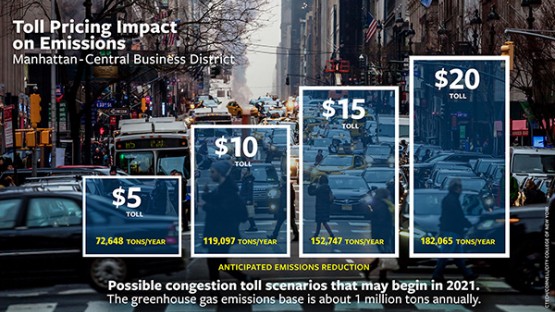New York City is among the most congested traffic spots in the world.
Soon, in an effort to ease some of the Big Apple’s legendary gridlock – and make the air more breathable – driving a car into midtown Manhattan will cost you.
New research by Cornell and the City College of New York (CCNY), which is part of the City University of New York system, shows that by enforcing a $20 toll for cars and taxis to enter the central business district of Manhattan, traffic congestion could be reduced by up to 40%, public transit ridership could grow by 6% and greenhouse gas emissions could be reduced by 15%.
“If we charge a high dollar amount of tolls, we can decrease the number of cars and taxis, shrink gridlock, bring down carbon dioxide emissions and reduce particulate matter,” said Oliver Gao, professor of engineering and director of Cornell’s Center for Transportation, Environment and Community Health. “This is good news for the environment and from a public health perspective.”
The research, “Evaluating the Traffic and Emissions Impacts of New York City Cordon Pricing,” was published May 1 in the journal Sustainability. In addition to Gao, authors are Cornell postdoctoral researcher Mohammad Tayarani, CCNY postdoc Amirhossein Baghestani and Mahdieh Allahviranloo, CCNY assistant professor of engineering.
Traffic woes have plagued Manhattan for decades. In the same 2019 New York state budget bill that spelled the end of plastic retail bags, Gov. Andrew Cuomo urged the Legislature to pass congestion traffic pricing to cull vehicles from the central business district of Manhattan, and to help fund more than $1 billion in public transit and subway infrastructure repairs.
Tolls were slated to begin Jan. 1, 2021, but delays due to the COVID-19 pandemic and delays in federal approval means collections will likely be pushed back, according to the governor and Metropolitan Transportation Authority.
About 1 million tons of greenhouse gas emissions – mostly carbon dioxide – come from automobile and truck traffic in lower Manhattan annually. In modeling different scenarios using air quality processing software, the researchers determined exhaust emission reductions based on the tolls charged to enter the central business district of Manhattan.
A toll of $5, they found, would result in a reduction of 72,648 tons of greenhouse gas emissions annually. For a $10 toll, the reduction would be 119,097 tons, and a $15 toll would yield a 157,747-ton drop.
A $20 toll would eliminate 40% of midtown traffic and reduce greenhouse gas emissions by 182,065 tons per year.
Entrance tolls will also drop the volume of particulate – soot and other tiny particles measuring less than 2.5 micrometers that are linked to poor health and give Manhattan a hanging haze, according to the paper.
“If we want to make cities livable for the next generation, installing these tolls are a practical solution, because these plans are not imaginary. They are facts of what will happen,” Tayarani said. “All of us know that policymakers don’t like to charge people for driving into the city. Policymakers try to avoid it. But if we want to avoid climate change impact, these are the kind of policies that need to be considered and implemented.”
Funding for this research was provided by the U.S. Department of Transportation’s University Transportation Centers Program.
















